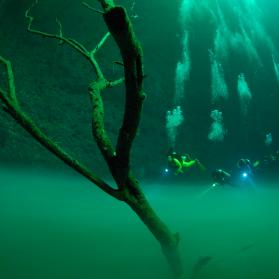Diving the Cenotes in Mexico.
The soil in the north of the Mexican peninsula of Yucatan consists of limestone. Characteristic of these soils is the fact that it is very porous. The soil can not hold the rainwater. For centuries long rainwater seeped through the porous limestone. In this way underground tunnels and caves with stalactites arose. When the seawater rised these caves were flooded. We all know the feeling of walking into a cave. But float between the stalactites is truly an experience you do not want to miss.
The name Cenote comes from the Mayan word Dzonot, which means sacred well. For the Maya people the cenotes were the main source of fresh water. They were regarded as sacred place. Near cenotes great Mayan cities were built. One example of such a city is Chichen Itza. In early 80’s divers began exploring the caves for recreational purposes. In Yucatan and Cozumel, hundreds of caves were discovered and mapped.
Even today there are still regularly discovered new caves and people are working hard to make a map of the cave systems.
Diving in the cenotes requires special techniques. Experienced cave divers have put lines into the cenotes to guide you through the cenote.
Without special training, cave diving is only alowed till the point that you can see the light from outside. To avoid getting too far into the caves there are special warning signs. A dive in the cenotes will always be accompanied by an experienced cave diver. He has the training to guide you safely through the cave.
The various cenotes have their own characteristics. Some cenotes are round or oval caves with clear water sources, while others look more like a muddy brown lake. The brown surface of the water in this second group of cenotes is also misleading. The first meters indeed are dark and brown, but underneath the water is crystal clear, as if the curtain is opened.

















Add new comment